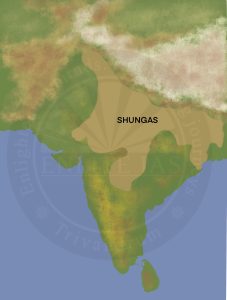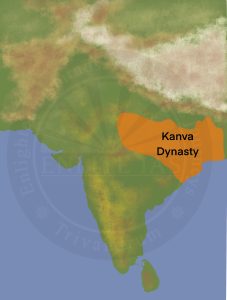Post Mauryan Period: Central India
Sunga Dynasty
- The Mauryan Empire was succeeded by the Sunga monarchy, an ancient Indian monarchy.
- It existed from around 185 BCE until 73 BCE.
- Pushyamitra Shunga founded the dynasty after the fall of the Mauryans.
- They were Brahmins, and the Bhagavata religion grew in importance.
- The capital of the Shunga empire was Pataliputra (modern Patna), and later the Shungas conducted court in Vidisha (Madhya Pradesh).
- Pushyamitra Sunga is often associated with the revival of Brahmanism and a patronage of Brahmanical traditions. He is said to have performed the Ashvamedha (horse sacrifice), a ritual associated with Hindu kingship.
- The Sunga Dynasty had a complex relationship with Buddhism. While Pushyamitra Sunga is sometimes depicted as hostile towards Buddhism, some later Sunga rulers were more tolerant and even patronised Buddhist institutions.

Contributions
- Patanjali’s Yoga Sutras & Mahabhasya were composed in this period.
- The Stupa at Sanchi was enlarged and the Bharhut Stupa in Madhya Pradesh was constructed.
Kanva Dynasty
- The Kanva dynasty reigned from 72 to 28 BCE.
- Vasudeva Kanva, a minister in the previous Shunga dynasty, is credited with founding the dynasty.
- After the fall of the Mauryan Empire in the second century BCE, the Shunga dynasty had ruled over much of northern and central India.

- The Kanva Dynasty was founded by Vasudeva, a minister in the court of the last Shunga ruler, Devabhuti. Vasudeva overthrew Devabhuti and established the Kanva rule.
- Kanva Rulers:
- The Kanva Dynasty had four rulers: Vasudeva, Bhumimitra, Narayana, and Susharman.
- They ruled for a short period of about 45 years.
- Extent of Rule:
- The Kanva Dynasty primarily ruled over the region of Magadha (modern-day Bihar) and its immediate surrounding areas.
- Their influence was relatively limited compared to the preceding Mauryan and Sunga dynasties.
- Decline:
- The Kanva Dynasty ended when it was overthrown by the rising Satavahana Dynasty, marking the end of their rule in 28 BCE.
- Cultural and Historical Impact:
- The Kanvas did not have as much influence on Indian culture, religion, or politics as the Mauryans or Shungas. Their brief rule is often considered a transitional period between major dynasties.
- Despite their short reign, the Kanva Dynasty is important in the historical continuity of ancient Indian kingdoms.

